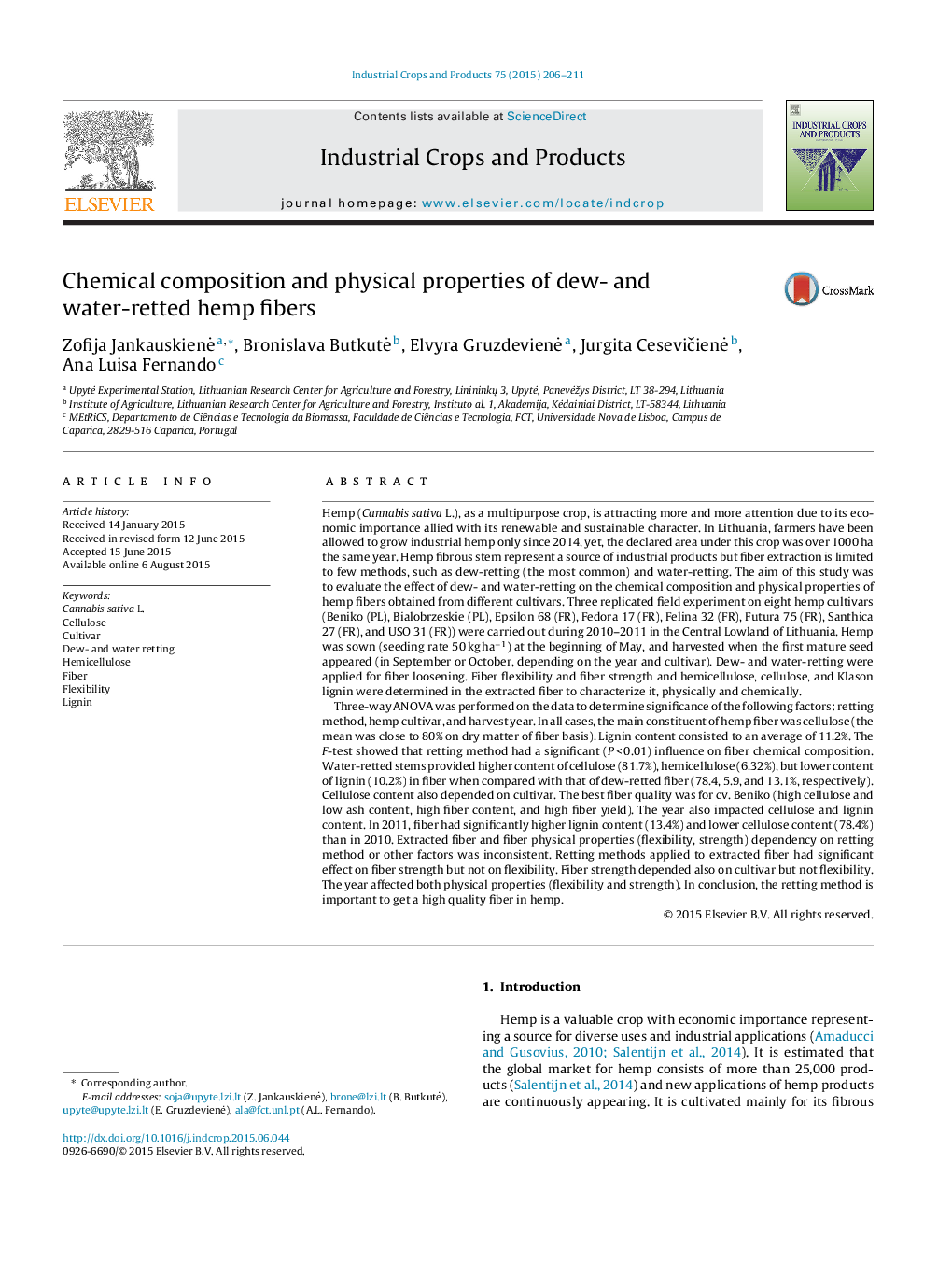| کد مقاله | کد نشریه | سال انتشار | مقاله انگلیسی | نسخه تمام متن |
|---|---|---|---|---|
| 4512845 | 1322172 | 2015 | 6 صفحه PDF | دانلود رایگان |
• Cellulose is the main constituent of hemp fiber (80%).
• The retting method has a significant influence on fiber chemical composition.
• Cultivar influenced ash content, fiber from stems, yield per ha, and fiber strength.
• The year is the most important factor influencing hemp fiber quantity and quality.
Hemp (Cannabis sativa L.), as a multipurpose crop, is attracting more and more attention due to its economic importance allied with its renewable and sustainable character. In Lithuania, farmers have been allowed to grow industrial hemp only since 2014, yet, the declared area under this crop was over 1000 ha the same year. Hemp fibrous stem represent a source of industrial products but fiber extraction is limited to few methods, such as dew-retting (the most common) and water-retting. The aim of this study was to evaluate the effect of dew- and water-retting on the chemical composition and physical properties of hemp fibers obtained from different cultivars. Three replicated field experiment on eight hemp cultivars (Beniko (PL), Bialobrzeskie (PL), Epsilon 68 (FR), Fedora 17 (FR), Felina 32 (FR), Futura 75 (FR), Santhica 27 (FR), and USO 31 (FR)) were carried out during 2010–2011 in the Central Lowland of Lithuania. Hemp was sown (seeding rate 50 kg ha−1) at the beginning of May, and harvested when the first mature seed appeared (in September or October, depending on the year and cultivar). Dew- and water-retting were applied for fiber loosening. Fiber flexibility and fiber strength and hemicellulose, cellulose, and Klason lignin were determined in the extracted fiber to characterize it, physically and chemically.Three-way ANOVA was performed on the data to determine significance of the following factors: retting method, hemp cultivar, and harvest year. In all cases, the main constituent of hemp fiber was cellulose (the mean was close to 80% on dry matter of fiber basis). Lignin content consisted to an average of 11.2%. The F-test showed that retting method had a significant (P < 0.01) influence on fiber chemical composition. Water-retted stems provided higher content of cellulose (81.7%), hemicellulose (6.32%), but lower content of lignin (10.2%) in fiber when compared with that of dew-retted fiber (78.4, 5.9, and 13.1%, respectively). Cellulose content also depended on cultivar. The best fiber quality was for cv. Beniko (high cellulose and low ash content, high fiber content, and high fiber yield). The year also impacted cellulose and lignin content. In 2011, fiber had significantly higher lignin content (13.4%) and lower cellulose content (78.4%) than in 2010. Extracted fiber and fiber physical properties (flexibility, strength) dependency on retting method or other factors was inconsistent. Retting methods applied to extracted fiber had significant effect on fiber strength but not on flexibility. Fiber strength depended also on cultivar but not flexibility. The year affected both physical properties (flexibility and strength). In conclusion, the retting method is important to get a high quality fiber in hemp.
Journal: Industrial Crops and Products - Volume 75, Part B, 30 November 2015, Pages 206–211
